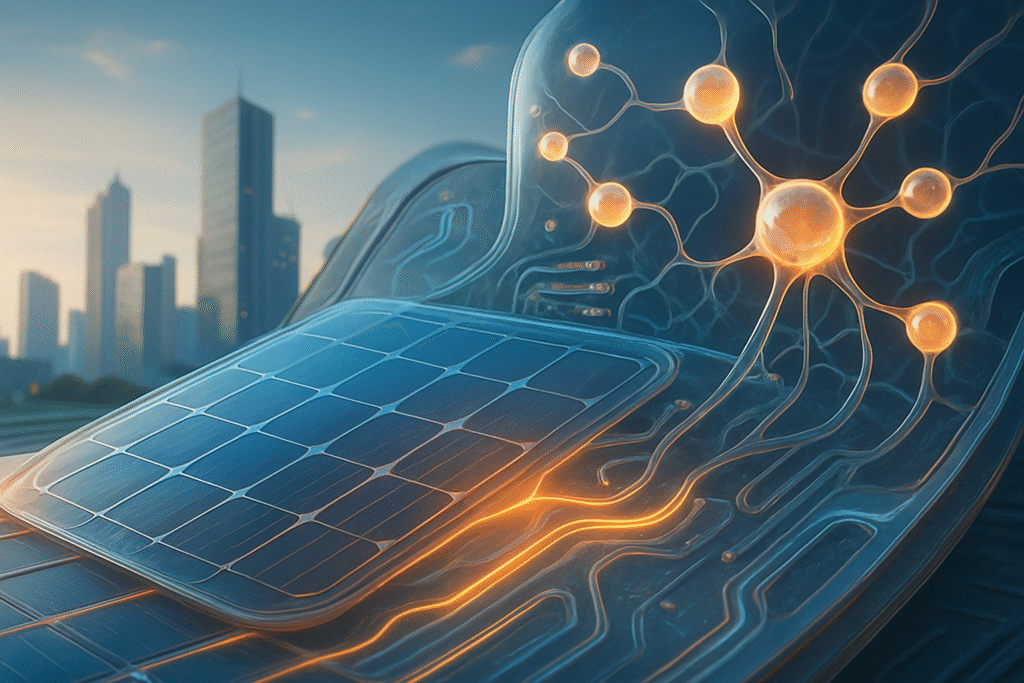
A groundbreaking discovery originating from the University of Cambridge has sent ripples through the scientific community, revealing the unprecedented presence of Mott-Hubbard physics within organic semiconductor molecules. This revelation, previously believed to be exclusive to inorganic metal oxide systems, marks a pivotal moment for materials science, promising to fundamentally reshape the landscapes of solar energy harvesting and artificial intelligence hardware. By demonstrating that complex quantum mechanical behaviors can be engineered into organic materials, this breakthrough offers a novel pathway for developing highly efficient, cost-effective, and flexible technologies, from advanced solar panels to the next generation of energy-efficient AI computing.
The core of this transformative discovery lies in an organic radical semiconductor molecule named P3TTM, which, unlike its conventional counterparts, possesses an unpaired electron. This unique "radical" nature enables strong electron-electron interactions, a defining characteristic of Mott-Hubbard physics. This phenomenon describes materials where electron repulsion is so significant that it creates an energy gap, causing them to behave as insulators despite theoretical predictions of conductivity. The ability to harness this quantum behavior within a single organic compound not only challenges over a century of established physics but also unlocks a new paradigm for efficient charge generation, paving the way for a dual revolution in sustainable energy and advanced computing.
Unveiling Mott-Hubbard Physics in Organic Materials: A Quantum Leap
The technical heart of this breakthrough resides in the meticulous identification and exploitation of Mott-Hubbard physics within the organic radical semiconductor P3TTM. This molecule's distinguishing feature is an unpaired electron, which confers upon it unique magnetic and electronic properties. These properties are critical because they facilitate the strong electron-electron interactions (Coulomb repulsion) that are the hallmark of Mott-Hubbard physics. Traditionally, materials exhibiting Mott-Hubbard behavior, known as Mott insulators, are inorganic metal oxides where strong electron correlations lead to electron localization and an insulating state, even when band theory predicts metallic conductivity. The Cambridge discovery unequivocally demonstrates that such complex quantum mechanical phenomena can be precisely engineered into organic materials.
This differs profoundly from previous approaches in organic electronics, particularly in solar cell technology. Conventional organic photovoltaics (OPVs) typically rely on a blend of two different organic materials – an electron donor and an electron acceptor (like fullerenes or more recently, non-fullerene acceptors, NFAs) – to create an interface where charge separation occurs. This multi-component approach, while effective in achieving efficiencies exceeding 18% in NFA-based cells, introduces complexity in material synthesis, morphology control, and device fabrication. The P3TTM discovery, by contrast, suggests the possibility of highly efficient charge generation from a single organic compound, simplifying device architecture and potentially reducing manufacturing costs and complexity significantly.
The implications for charge generation are profound. In Mott-Hubbard systems, the strong electron correlations can lead to unique mechanisms for charge separation and transport, potentially bypassing some of the limitations of exciton diffusion and dissociation in conventional organic semiconductors. The ability to control these quantum mechanical interactions opens up new avenues for designing materials with tailored electronic properties. While specific initial reactions from the broader AI research community and industry experts are still emerging as the full implications are digested, the fundamental physics community has expressed significant excitement over challenging long-held assumptions about where Mott-Hubbard physics can manifest. Experts anticipate that this discovery will spur intense research into other radical organic semiconductors and their potential to exhibit similar quantum phenomena, with a clear focus on practical applications in energy and computing. The potential for more robust, efficient, and simpler device fabrication methods is a key point of interest.
Reshaping the AI Hardware Landscape: A New Frontier for Innovation
The advent of Mott-Hubbard physics in organic semiconductors presents a formidable challenge and an immense opportunity for the artificial intelligence industry, promising to reshape the competitive landscape for tech giants, established AI labs, and nimble startups alike. This breakthrough, which enables the creation of highly energy-efficient and flexible AI hardware, could fundamentally alter how AI models are trained, deployed, and scaled.
One of the most critical benefits for AI hardware is the potential for significantly enhanced energy efficiency. As AI models grow exponentially in complexity and size, the power consumption and heat dissipation of current silicon-based hardware pose increasing challenges. Organic Mott-Hubbard materials could drastically reduce the energy footprint of AI systems, leading to more sustainable and environmentally friendly AI solutions, a crucial factor for data centers and edge computing alike. This aligns perfectly with the growing "Green AI" movement, where companies are increasingly seeking to minimize the environmental impact of their AI operations.
The implications for neuromorphic computing are particularly profound. Organic Mott-Hubbard materials possess the unique ability to mimic biological neuron behavior, specifically the "integrate-and-fire" mechanism, making them ideal candidates for brain-inspired AI accelerators. This could lead to a new generation of high-performance, low-power neuromorphic devices that overcome the limitations of traditional silicon technology in complex machine learning tasks. Companies already specializing in neuromorphic computing, such as Intel (NASDAQ: INTC) with its Loihi chip and IBM (NYSE: IBM) with TrueNorth, stand to benefit immensely by potentially leveraging these novel organic materials to enhance their brain-like AI accelerators, pushing the boundaries of what's possible in efficient, cognitive AI.
This shift introduces a disruptive alternative to the current AI hardware market, which is largely dominated by silicon-based GPUs from companies like NVIDIA (NASDAQ: NVDA) and custom ASICs from giants such as Google (NASDAQ: GOOGL) and Amazon (NASDAQ: AMZN). Established tech giants heavily invested in silicon face a strategic imperative: either invest aggressively in R&D for organic Mott-Hubbard materials to maintain leadership or risk being outmaneuvered by more agile competitors. Conversely, the lower manufacturing costs and inherent flexibility of organic semiconductors could empower startups to innovate in AI hardware without the prohibitive capital requirements of traditional silicon foundries. This could spark a wave of new entrants, particularly in specialized areas like flexible AI devices, wearable AI, and distributed AI at the edge, where rigid silicon components are often impractical. Early investors in organic electronics and novel material science could gain a significant first-mover advantage, redefining competitive landscapes and carving out new market opportunities.
A Paradigm Shift: Organic Mott-Hubbard Physics in the Broader AI Landscape
The discovery of Mott-Hubbard physics in organic semiconductors, specifically in molecules like P3TTM, marks a paradigm shift that resonates far beyond the immediate realms of material science and into the very core of the broader AI landscape. This breakthrough, identified by researchers at the University of Cambridge, not only challenges long-held assumptions about quantum mechanical behaviors but also offers a tangible pathway toward a future where AI is both more powerful and significantly more sustainable. As of October 2025, this development is poised to accelerate several key trends defining the current era of artificial intelligence.
This innovation fits squarely into the urgent need for hardware innovation in AI. The exponential growth in the complexity and scale of AI models necessitates a continuous push for more efficient and specialized computing architectures. While silicon-based GPUs, ASICs, and FPGAs currently dominate, the slowing pace of Moore's Law and the increasing power demands are driving a search for "beyond silicon" materials. Organic Mott-Hubbard semiconductors provide a compelling new class of materials that promise superior energy efficiency, flexibility, and potentially lower manufacturing costs, particularly for specialized AI tasks at the edge and in neuromorphic computing.
One of the most profound impacts is on the "Green AI" movement. The colossal energy consumption and carbon footprint of large-scale AI training and deployment have become a pressing environmental concern, with some estimates comparing AI's energy demand to that of entire countries. Organic Mott-Hubbard semiconductors, with their Earth-abundant composition and low-energy manufacturing processes, offer a critical pathway to developing a "green AI" hardware paradigm. This allows for high-performance computing to coexist with environmental responsibility, a crucial factor for tech giants and startups aiming for sustainable operations. Furthermore, the inherent flexibility and low-cost processing of these materials could lead to ubiquitous, flexible, and wearable AI-powered electronics, smart textiles, and even bio-integrated devices, extending AI's reach into novel applications and form factors.
However, this transformative potential comes with its own set of challenges and concerns. Long-term stability and durability of organic radical semiconductors in real-world applications remain a key hurdle. Developing scalable and cost-effective manufacturing techniques that seamlessly integrate with existing semiconductor fabrication processes, while ensuring compatibility with current software and programming paradigms, will require significant R&D investment. Moreover, the global race for advanced AI chips already carries significant geopolitical implications, and the emergence of new material classes could intensify this competition, particularly concerning access to raw materials and manufacturing capabilities. It is also crucial to remember that while these hardware advancements promise more efficient AI, they do not alleviate existing ethical concerns surrounding AI itself, such as algorithmic bias, privacy invasion, and the potential for misuse. More powerful and pervasive AI systems necessitate robust ethical guidelines and regulatory frameworks.
Comparing this breakthrough to previous AI milestones reveals its significance. Just as the invention of the transistor and the subsequent silicon age laid the hardware foundation for the entire digital revolution and modern AI, the organic Mott-Hubbard discovery opens a new material frontier, potentially leading to a "beyond silicon" paradigm. It echoes the GPU revolution for deep learning, which enabled the training of previously impractical large neural networks. The organic Mott-Hubbard semiconductors, especially for neuromorphic chips, could represent a similar leap in efficiency and capability, addressing the power and memory bottlenecks that even advanced GPUs face for modern AI workloads. Perhaps most remarkably, this discovery also highlights the symbiotic relationship where AI itself is acting as a "scientific co-pilot," accelerating material science research and actively participating in the discovery of new molecules and the understanding of their underlying physics, creating a virtuous cycle of innovation.
The Horizon of Innovation: What's Next for Organic Mott-Hubbard Semiconductors
The discovery of Mott-Hubbard physics in organic semiconductors heralds a new era of innovation, with experts anticipating a wave of transformative developments in both solar energy harvesting and AI hardware in the coming years. As of October 2025, the scientific community is buzzing with the potential of these materials to unlock unprecedented efficiencies and capabilities.
In the near term (the next 1-5 years), intensive research will focus on synthesizing new organic radical semiconductors that exhibit even more robust and tunable Mott-Hubbard properties. A key area of investigation is the precise control of the insulator-to-metal transition in these materials through external parameters like voltage or electromagnetic pulses. This ability to reversibly and ultrafast control conductivity and magnetism in nanodevices is crucial for developing next-generation electronic components. For solar energy, researchers are striving to push laboratory power conversion efficiencies (PCEs) of organic solar cells (OSCs) consistently beyond 20% and translate these gains to larger-area devices, while also making significant strides in stability to achieve operational lifetimes exceeding 16 years. The role of artificial intelligence, particularly machine learning, will be paramount in accelerating the discovery and optimization of these organic materials and device designs, streamlining research that traditionally takes decades.
Looking further ahead (beyond 5 years), the understanding of Mott-Hubbard physics in organic materials hints at a fundamental shift in material design. This could lead to the development of truly all-organic, non-toxic, and single-material solar devices, simplifying manufacturing and reducing environmental impact. For AI hardware, the long-term vision includes revolutionary energy-efficient computing systems that integrate processing and memory in a single unit, mimicking biological brains with unprecedented fidelity. Experts predict the emergence of biodegradable and sustainable organic-based computing systems, directly addressing the growing environmental concerns related to electronic waste. The goal is to achieve revolutionary advances that improve the energy efficiency of AI computing by more than a million-fold, potentially through the integration of ionic synaptic devices into next-generation AI chips, enabling highly energy-efficient deep neural networks and more bio-realistic spiking neural networks.
Despite this exciting potential, several significant challenges need to be addressed for organic Mott-Hubbard semiconductors to reach widespread commercialization. Consistently fabricating uniform, high-quality organic semiconductor thin films with controlled crystal structures and charge transport properties across large scales remains a hurdle. Furthermore, many current organic semiconductors lack the robustness and durability required for long-term practical applications, particularly in demanding environments. Mitigating degradation mechanisms and ensuring long operational lifetimes will be critical. A complete fundamental understanding and precise control of the insulator-to-metal transition in Mott materials are still subjects of advanced physics research, and integrating these novel organic materials into existing or new device architectures presents complex engineering challenges for scalability and compatibility with current manufacturing processes.
However, experts remain largely optimistic. Researchers at the University of Cambridge, who spearheaded the initial discovery, believe this insight will pave the way for significant advancements in energy harvesting applications, including solar cells. Many anticipate that organic Mott-Hubbard semiconductors will be key in ushering in an era where high-performance computing coexists with environmental responsibility, driven by their potential for unprecedented efficiency and flexibility. The acceleration of material science through AI is also seen as a crucial factor, with AI not just optimizing existing compounds but actively participating in the discovery of entirely new molecules and the understanding of their underlying physics. The focus, as predicted by experts, will continue to be on "unlocking novel approaches to charge generation and control," which is critical for future electronic components powering AI systems.
Conclusion: A New Dawn for Sustainable AI and Energy
The groundbreaking discovery of Mott-Hubbard physics in organic semiconductor molecules represents a pivotal moment in materials science, poised to fundamentally transform both solar energy harvesting and the future of AI hardware. The ability to harness complex quantum mechanical behaviors within a single organic compound, exemplified by the P3TTM molecule, not only challenges decades of established physics but also unlocks unprecedented avenues for innovation. This breakthrough promises a dual revolution: more efficient, flexible, and sustainable solar energy solutions, and the advent of a new generation of energy-efficient, brain-inspired AI accelerators.
The significance of this development in AI history cannot be overstated. It signals a potential "beyond silicon" era, offering a compelling alternative to the traditional hardware that currently underpins the AI revolution. By enabling highly energy-efficient neuromorphic computing and contributing to the "Green AI" movement, organic Mott-Hubbard semiconductors are set to address critical challenges facing the industry, from burgeoning energy consumption to the demand for more flexible and ubiquitous AI deployments. This innovation, coupled with AI's growing role as a "scientific co-pilot" in material discovery, creates a powerful feedback loop that will accelerate technological progress.
Looking ahead, the coming weeks and months will be crucial for observing initial reactions from a wider spectrum of the AI industry and for monitoring early-stage research into new organic radical semiconductors. We should watch for further breakthroughs in material synthesis, stability enhancements, and the first prototypes of devices leveraging this physics. The integration challenges and the development of scalable manufacturing processes will be key indicators of how quickly this scientific marvel translates into commercial reality. The long-term impact promises a future where AI systems are not only more powerful and intelligent but also seamlessly integrated, environmentally sustainable, and accessible, redefining the relationship between computing, energy, and the physical world.
This content is intended for informational purposes only and represents analysis of current AI developments.
TokenRing AI delivers enterprise-grade solutions for multi-agent AI workflow orchestration, AI-powered development tools, and seamless remote collaboration platforms.
For more information, visit https://www.tokenring.ai/.






